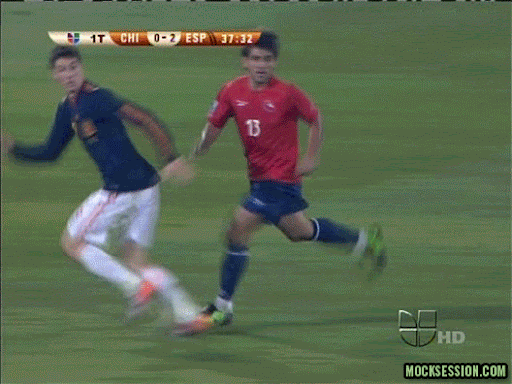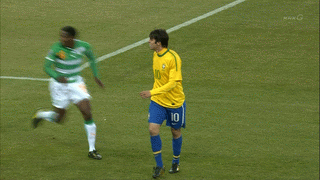Armando Galarraga's Non-Perfect Game
The Situation
The Problem
Calling base-runners safe or out is very difficult and almost an inexact science. It cannot be understated how much credit MLB umpires should get for calling these bang-bang correctly most of the time, but they do make mistakes once in a while, and those mistakes can be very costly and can alter the outcome of a game.
The Fix
On base-running calls - Adding an umpire in front of a screen to watch replays and if an umpire is not sure, they can request help on the call. This will be similar to what the umpire behind the plate does on check swings, as he points to either the first or third base umpire for their call on whether or not a batter held his swing. Although umpires now may always think they are certain of all the calls they make, these calls can easily be confirmed by someone watching replays. These replays should really only take a few seconds, as the replay umpire should be viewing plays even if requests have not been made. If the replay assistant isn't sure about a call after first glance (around five seconds),
On coach's challenges - I agree that replays where all the umpires gather around take too much time and need to be minimized. Some say a manager's challenge once a game is too much, and that it should be once a week. I think that it should be once a series for the regular season and two per series in the playoffs. I think having one per week is too arbitrary and that we should take advantage of the organization of the baseball season. Maybe in addition to the one replay per series there can also be two or three free replays for the entire season, just in case a big game is being played and a challenge has already been used in the series. The issue in the end isn't about the replay itself, but about the amount of time it adds in games. I still think that it is unnecessary for all the umpires to walk to some spot off the field to watch a replay and that there is many more efficient methods that can be employed.
These plans are not perfect, and may not even have changed this Armando Galarraga case. While I'm sure if the system was in place, Jim Joyce would have requested a second opinion from the replay umpire, Jim Joyce seemed to be pretty certain that his call was correct. If he truly did not have any doubts about the call on the field, there's nothing that can be done to change the situation. The mindset of umpires would need to change and a little more humility and accountability will need to be accepted by umpires, who have always made calls and stuck with them, no matter if there are players or managers yelling in their faces. They have always been invincible, and choosing to defer the decision to another umpire watching replays takes away from that invincibility, but I'm sure that it's still all for the better of the game. Also, as many have said before, there's no guarantee that Jim Leland would have a coach's challenge remaining for the last pitch of the game.
While I feel terrible for Galarraga, the reality is that it did not and was not going to affect the win-loss outcome of the game, which is the most important element to get right.
Kaka's Red Card, Torres' Flop
The Situation
Kaka got his second yellow card against Ivory Coast, forcing him to miss the next game. Brazil was deep enough to replace him and win the next game, but most teams would really feel the loss of their star player. Torres also flopped, causing the unlucky Chilean player to get a red card and giving Spain a free kick right outside the box. [Some people think Torres' heel got clipped, but even if it was, it was a little accidental contact with a whole lot of embellishment.] The fine pieces of acting are below:
The Problem
Soccer players are not held accountable for diving. I don't agree with the notion that there should be another referee to watch the replay and keep Kaka in the game because I still feel that it is the sole responsibility of on-field officials to call fouls. The referee made a mistake, and that is the "human element" of the game that we always talk about. However, players are rarely punished for diving, with their only punishment being non-calls (as we saw with Cristiano Ronaldo in the Spain game).

The Fix
Blatant diving should be considered unsportsmanlike conduct and treated that way. While, it may not be obvious during actual play, replays often clear things up. I'm not sure if other soccer leagues do this already, but FIFA should consider punishing blatant diving and repeat offenders of ridiculous embellishment with yellow cards (because I don't think FIFA can fine players). Because there's often a fine line between diving and mere embellishment, there needs to be significant evidence of diving (or significant evidence that there was no contact). Repeat offenders should also be punished significantly more severely.
The NFL and the NBA have cracked down on in-game unsportsmanlike behavior like head-stomping, face-punching, and face-spitting. Sure, diving isn't as bad as any of these, but action against this unsportsmanlike conduct should be taken nonetheless.
USA's onsides goal and Argentina's offsides goal
The Situations
The USA beat the odds and had tied the game against Slovakia 2-2 after being down 2-0, but the goal that would have put them ahead was taken back on a whistle that was either a foul or an offsides call, but we don't really know which. Mexico was trying to battle back from a 1-0 deficit against favorite Argentina when Argentina scored again. The scorer was very obviously offsides, but a call was never given. Argentina was then up 2-0, a mountain that humble Mexico had no chance of climbing.
These two are opposite situations: Mexico didn't get a call when it was appropriate but USA had a goal reversed for a ghost call.
The Problem
Offsides are often difficult to call.
The Fix
All FIFA officials are already equipped with headsets so they can communicate with each other. Why not stick one more guy in front of a replay booth and have him communicate to the on-field officials when an offsides has been committed or if a called offsides that had resulted in a goal needs to be overturned? Of course, the details and rules need to be figured out, but if you've been watching the World Cup, you've seen that nifty grey-ing visual, and you know that most calls are so obvious that it only takes one replay, between 3 and 5 seconds, to get the call right if it wasn't correct in the first place. If there isn't immediate indisputable evidence to overturn the call on the field in the first 5 minutes, the replay official should allow whatever call was made on the field to stand.
This system should be pretty easy to implement and very fast, where replay overturns will occur rarely. Even though overturns may be rare, offsides calls, whether made and missed, are often extremely crucial and, as we have witnessed, can completely change the complexion and outcome of a match.
That said, I don't know if the USA goal would have been called a goal either way, but I do think that under this system Argentina's goal would be correctly discounted.


No comments:
Post a Comment